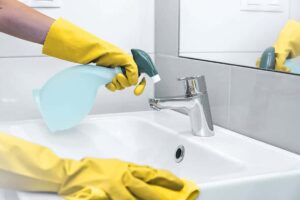Disinfecting in the Face of Viruses and Other Biohazards: Helpful Tips
 With the empty shelves at stores everywhere – a shortage of toilet paper, hand sanitizers, hand soap, and disinfectant cleaners, people are understandably concerned about protecting themselves from the spread of COVID-19. We’ve seen lots of reports and social media posts showing people using disinfectant cleaning wipes (most of them improperly). Here is some basic information on cleaning and disinfecting that is generally applicable to any infectious agent.
With the empty shelves at stores everywhere – a shortage of toilet paper, hand sanitizers, hand soap, and disinfectant cleaners, people are understandably concerned about protecting themselves from the spread of COVID-19. We’ve seen lots of reports and social media posts showing people using disinfectant cleaning wipes (most of them improperly). Here is some basic information on cleaning and disinfecting that is generally applicable to any infectious agent.
- Cleaners and disinfectants are two separate things. Cleaners don’t disinfect, nor do disinfectants clean. Anything you do to take care of germs in your home requires two steps: clean first, then disinfect.
- Most people use disinfectants improperly. Simply wiping and drying off the surface accomplishes nothing. In fact, you may make things worse. Whether you use sprays or wipes, wipe in ONE direction only. Otherwise all you are doing is spreading the germs by wiping back and forth. You’re dragging a cloth or wipe that is now germ-laden over a surface you’ve previously applied disinfectant to, effectively re-contaminating it.
- Disinfectants must remain wet to be effective. Once a surface is clean, if you use a disinfectant product, it MUST remain wet on the surface for a sufficient amount of time in order to kill the germs. For example, a bleach solution requires about a 10-minute time frame of remaining wet to be effective. Other disinfectants may recommend 3 minutes. Whatever you use as a disinfectant, read the label for the manufacturer’s recommendation.
- Wear gloves when cleaning or disinfecting – disposables are best. If you use non-disposable gloves, they will need to be disinfected as well, such as soaking in a bleach solution. If you are not wearing gloves, your hands can become infected, and then whatever you touch (like your face) will be contaminated.
- Sponges, wiping cloths, etc. should either be disposed of properly or sanitized. The best method? Your microwave. Research shows that 2 minutes in a microwave will effectively kill bacteria and viruses.
- Wipes or sprays? Previously it was felt that wipes were a better way to disinfect than spray cleaners, mostly because they were a one-use item that was convenient and could be easily disposed of. However, many experts believe that spray disinfectants are a better way to go. In fact, Dr. Oz today stated when he guest hosted on “The View” that he believed using wipes did more to spread it than kill germs. (He has said this in other interviews as well. You can read more of his coronavirus survival tips in this article.)
- Don’t forget to sanitize items your hands touch. This includes phones, tablets, computer mouses, keyboards, etc., and even your car keys – not just hard surfaces in your home. Keep in mind that certain solutions should NOT be used on digital items, so check with the manufacturer for their recommendations.
As a company who professionally cleans and disinfects to address the presence of viruses, bacteria, and other biohazards, we take every precaution to make sure we’re killing germs and not just cleaning surfaces. If you’ve got questions about our services or the area we cover, please contact us.



